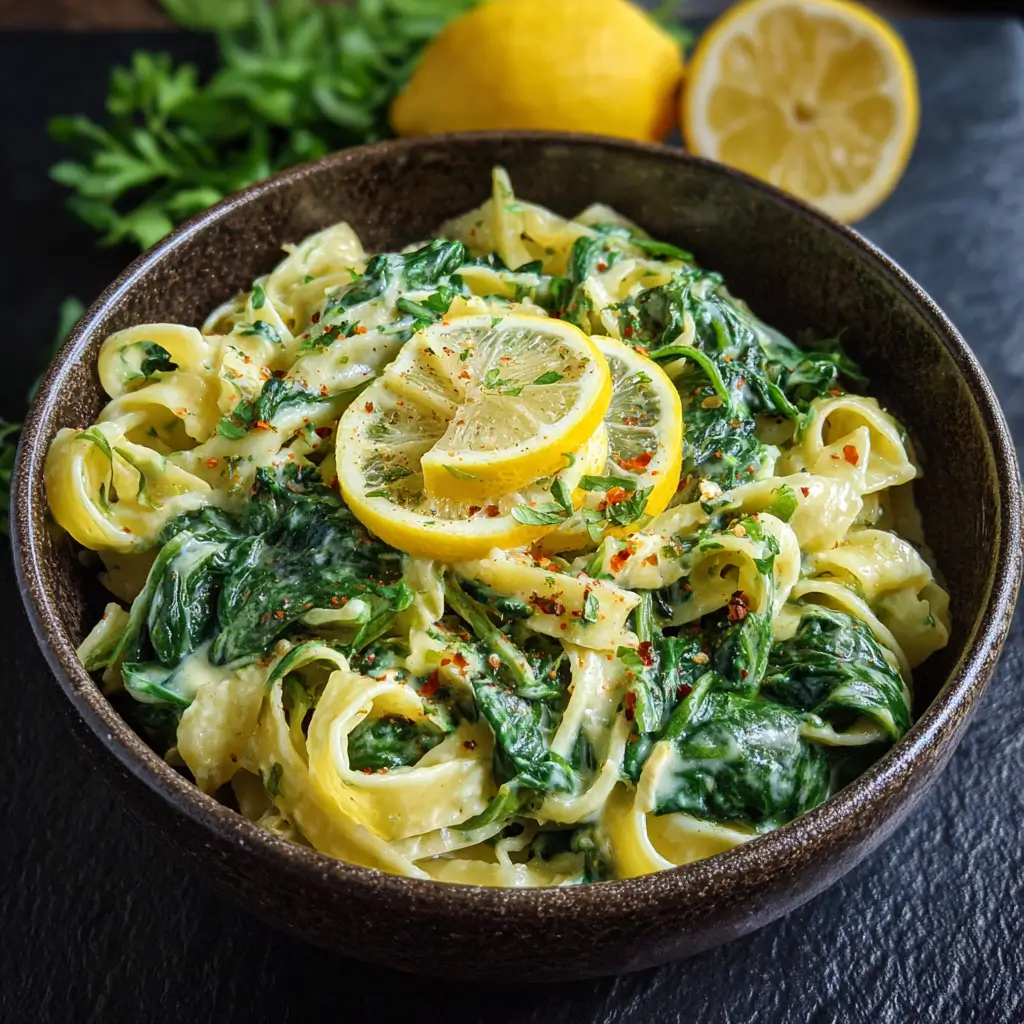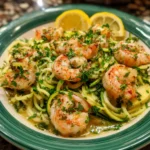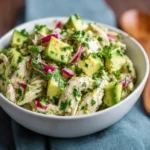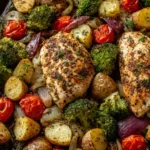Creamy Lemon Spinach Pasta: A Zesty, Comforting Delight
If you’re in the mood for a dish that’s both luxurious and light, creamy lemon spinach pasta is the perfect choice. This modern classic brings together the richness of cream with the bright acidity of lemon and the earthy freshness of spinach. It’s a harmonious blend of flavors and textures that feels indulgent yet wholesome—ideal for weeknight dinners or impressing guests at a casual dinner party. With its vibrant green hue and citrusy aroma, this dish is as pleasing to the senses as it is satisfying to the palate.
The History Behind Creamy Lemon Spinach Pasta
While creamy pasta dishes have roots stretching back centuries in Italian cuisine—particularly in regions like Emilia-Romagna where butter, cream, and Parmesan are staples—the specific combination of lemon and spinach in a creamy sauce is a more recent innovation. It gained popularity in the late 20th century as global palates began embracing lighter, fresher takes on traditionally rich dishes. The addition of lemon juice or zest brought a refreshing contrast to heavy dairy elements, making such recipes more balanced and suitable for spring and summer menus.
In the United States and other Western countries, creamy lemon spinach pasta emerged in the 1990s and 2000s as part of the “gourmet comfort food” trend, often seen in bistro-style restaurants and lifestyle cooking shows. Home cooks embraced it for its simplicity, elegance, and versatility. Today, it’s a beloved recipe found across food blogs, cookbooks, and family kitchens worldwide, frequently adapted with plant-based alternatives or protein boosts to suit diverse dietary preferences.
Ingredients Breakdown: What Makes This Dish Shine?
The magic of creamy lemon spinach pasta lies in its carefully chosen ingredients, each playing a crucial role in building flavor, texture, and nutrition:
- Pasta: Traditionally, fettuccine or linguine is used for its ability to hold creamy sauces, but penne, farfalle, or even gluten-free varieties work well too.
- Fresh Spinach: Tender baby spinach wilts beautifully into the sauce, adding color, nutrients, and a mild earthiness without overpowering other flavors.
- Lemon: Both the zest and juice contribute essential brightness. Zest contains aromatic oils that elevate the dish, while the juice adds tanginess that cuts through the richness of the cream.
- Heavy Cream: Provides a luscious, velvety base. For a lighter version, half-and-half or whole milk can be used, though the texture will be thinner.
- Garlic: Sautéed gently to infuse the sauce with warmth and depth without turning bitter.
- Butter: Enhances silkiness and carries fat-soluble flavors, helping meld all components together.
- Grated Parmesan Cheese: Adds umami, saltiness, and helps thicken the sauce naturally due to its melting properties.
- Salt & Black Pepper: Essential seasonings that balance and enhance all other flavors.
- Nutritional Yeast (optional): A popular vegan substitute for Parmesan, offering a cheesy, nutty flavor.
- Olive Oil: Used for sautéing garlic and spinach, adding a fruity note and healthy fats.
Step-by-Step Recipe: How to Make Creamy Lemon Spinach Pasta
Serves: 4 | Prep Time: 10 minutes | Cook Time: 15 minutes | Total Time: 25 minutes
- Boil the Pasta: Bring a large pot of salted water to a rolling boil. Add 12 oz (340g) of your preferred pasta and cook according to package instructions until al dente. Reserve ½ cup of pasta water before draining.
- Prepare the Lemon Base: While the pasta cooks, zest one large lemon and set aside. Juice the same lemon to yield about ¼ cup of fresh juice. Set both aside.
- Sauté the Aromatics: In a large skillet or sauté pan, heat 2 tablespoons of olive oil over medium heat. Add 3 cloves of minced garlic and cook for 30–60 seconds until fragrant but not browned.
- Wilt the Spinach: Add 5 oz (about 5 cups) of fresh baby spinach in batches, stirring continuously until wilted and tender—about 2–3 minutes. Remove from heat if needed to prevent overcooking.
- Create the Cream Sauce: Return the pan to medium-low heat. Add 1 cup of heavy cream, stirring gently. Warm through without boiling. Stir in ½ cup of freshly grated Parmesan cheese until melted and smooth.
- Add Lemon Flavor: Stir in the lemon juice and zest. Season with salt and freshly ground black pepper to taste. The sauce should be creamy with a noticeable but balanced citrus kick.
- Combine with Pasta: Drain the cooked pasta and add it directly to the skillet with the sauce. Toss thoroughly to coat every strand. If the sauce is too thick, gradually add reserved pasta water, one tablespoon at a time, until desired consistency is reached.
- Finish and Serve: Taste and adjust seasoning. Add more lemon juice for tartness, salt for savoriness, or pepper for spice. Optionally, drizzle with extra virgin olive oil or sprinkle with red pepper flakes for complexity.
- Garnish and Plate: Divide among warm bowls. Top with additional Parmesan, a twist of black pepper, a few fresh spinach leaves, or microgreens for presentation.
Tips for the Perfect Creamy Lemon Spinach Pasta
- Don’t Overcook the Garlic: Burnt garlic turns bitter. Keep the heat low and stir constantly during sautéing.
- Use Fresh Lemon Juice: Bottled lemon juice lacks the vibrancy and natural sweetness of fresh. Always opt for freshly squeezed when possible.
- Reserve Pasta Water: The starchy liquid helps bind the sauce to the pasta and improves texture. Never skip this step!
- Add Cheese Off the Heat: To prevent clumping or separation, remove the pan from direct heat before adding Parmesan, then return briefly to melt smoothly.
- Cook Pasta Al Dente: Overcooked pasta becomes mushy when tossed in sauce. Test a minute before the suggested cooking time.
- Brighten Before Serving: A final squeeze of lemon juice just before plating can refresh the flavors and boost aroma.
- Balance the Cream: If the sauce tastes too rich, add a splash of lemon juice or a pinch of red pepper flakes to cut through the fat.
Variations and Customizations
This recipe is highly adaptable. Here are some creative ways to personalize your creamy lemon spinach pasta:
- Protein-Packed Version: Add grilled chicken breast, shrimp, salmon, or seared scallops. For plant-based options, include chickpeas, white beans, lentils, or marinated tofu.
- Vegan Adaptation: Substitute heavy cream with full-fat coconut milk or cashew cream. Use nutritional yeast instead of Parmesan and vegan butter or olive oil.
- Gluten-Free Option: Use high-quality gluten-free pasta (like brown rice or chickpea-based). Ensure all other ingredients are certified GF if necessary.
- Herb Infusion: Stir in chopped fresh basil, dill, parsley, or chives at the end for added herbal notes.
- Creamy Avocado Twist: Blend ripe avocado into the sauce for extra creaminess and healthy fats without dairy.
- Mushroom Upgrade: Sauté sliced cremini or shiitake mushrooms with the garlic for an umami-rich, earthy layer.
- Spicy Kick: Add crushed red pepper flakes while sautéing garlic, or finish with a drizzle of chili oil.
- Seafood Delight: Combine shrimp and crabmeat for a luxurious surf-style version, enhanced with a touch of white wine in the sauce.
- Tomato Addition: Fold in halved cherry tomatoes or sun-dried tomatoes for bursts of sweetness and color.
- Breakfast Pasta: Top with a poached or fried egg for a decadent brunch option.
Health Considerations and Nutritional Value
Creamy lemon spinach pasta, while delicious, can be rich due to the cream and cheese content. However, it also offers several nutritional benefits, especially when prepared with mindful modifications:
- Spinach: Packed with iron, vitamin K, folate, antioxidants (like lutein), and fiber. Supports bone health, immunity, and digestion.
- Lemon: High in vitamin C, which boosts immune function and enhances iron absorption from spinach.
- Dairy: Provides calcium, protein, and vitamin B12, though saturated fat content should be monitored in large quantities.
- Pasta: A source of carbohydrates for energy. Whole grain or legume-based pastas increase fiber and protein intake.
Estimated Nutrition per Serving (1/4 of recipe, with fettuccine, heavy cream, Parmesan, spinach, lemon, garlic):
- Calories: ~480 kcal
- Total Fat: 25g (Saturated Fat: 14g)
- Cholesterol: 65mg
- Sodium: 500–700mg (varies with cheese and added salt)
- Carbohydrates: 48g (Fiber: 4g, Sugars: 4g)
- Protein: 16g
- Vitamin A: 180% DV
- Vitamin C: 35% DV
- Iron: 18% DV
- Calcium: 25% DV
For a Healthier Version:
- Use half-and-half or whole milk instead of heavy cream.
- Opt for reduced-fat Parmesan or use less quantity.
- Choose whole wheat or chickpea pasta for higher fiber and protein.
- Reduce butter and increase olive oil for heart-healthy monounsaturated fats.
- Add more vegetables like zucchini, peas, or roasted bell peppers to boost volume and nutrients without excess calories.
Full Ingredient List
- 12 oz (340g) fettuccine, linguine, or pasta of choice
- 5 oz (about 5 cups) fresh baby spinach
- 1 large lemon (zested and juiced)
- 1 cup heavy cream (or substitute)
- ½ cup freshly grated Parmesan cheese (plus extra for serving)
- 3 cloves garlic, minced
- 2 tbsp olive oil
- 2 tbsp unsalted butter (optional, for extra richness)
- Salt, to taste
- Freshly ground black pepper, to taste
- Optional: red pepper flakes, fresh herbs, protein additions
Detailed Directions
- Cook the Pasta: Fill a large pot with water, add 1–2 teaspoons of salt, and bring to a boil. Add pasta and cook until just tender but still firm to the bite. Stir occasionally to prevent sticking. Before draining, ladle out ½ cup of starchy pasta water and set aside.
- Prep Citrus Elements: Wash the lemon thoroughly. Use a fine grater to remove the yellow zest only (avoid white pith). Cut the lemon in half and juice it using a citrus press or fork. Strain seeds and pulp if needed.
- Sauté Garlic in Oil: In a large nonstick or stainless steel skillet, heat olive oil over medium heat. Add minced garlic and stir constantly for 30–60 seconds until golden and aromatic. Do not let it burn.
- Wilt Spinach: Add spinach in handfuls, stirring continuously. It will quickly reduce in volume. Cook just until limp and bright green—about 2–3 minutes total. Remove from heat temporarily if sauce isn’t ready.
- Build the Cream Sauce: Return pan to medium-low heat. Pour in heavy cream and warm gently, stirring. Bring to a bare simmer—do not boil vigorously. Add butter (if using) and stir until melted.
- Incorporate Cheese: Reduce heat to low. Gradually whisk in Parmesan, a little at a time, until fully melted and the sauce is smooth. Avoid high heat to prevent curdling.
- Add Lemon Components: Stir in lemon juice and zest. Season with salt and several grinds of black pepper. Taste and adjust—add more lemon for acidity, salt for balance, or pepper for heat.
- Combine with Pasta: Add drained pasta directly to the skillet. Toss vigorously with tongs or two forks to evenly coat each strand. If the mixture seems dry, add reserved pasta water 1 tablespoon at a time until creamy and cohesive.
- Final Adjustments: Check seasoning again. Some may prefer an extra pinch of zest or a final squeeze of lemon for brightness.
- Serve Immediately: Plate promptly while hot. Garnish with extra Parmesan, cracked black pepper, fresh herbs, or a drizzle of high-quality olive oil.
Frequently Asked Questions (FAQ)
Can I make creamy lemon spinach pasta ahead of time?
Yes, but it’s best served fresh. Reheated pasta may become dry or separate. To reheat, place leftovers in a pan with a splash of milk or broth and warm gently over low heat, stirring frequently.
Why did my sauce separate or become grainy?
This usually happens due to high heat causing the dairy to curdle or the cheese to seize. Always melt cheese off direct heat and avoid boiling the cream. Using freshly grated Parmesan (not pre-grated with anti-caking agents) also helps maintain smoothness.
Can I freeze this dish?
Not recommended. Cream-based sauces tend to break down when frozen and thawed, resulting in a watery or oily texture. Best enjoyed fresh or refrigerated for up to 3 days.
What can I use instead of heavy cream?
Options include half-and-half, whole milk, evaporated milk, or blended silken tofu/cashew cream for vegan versions. Note that substitutes may result in a thinner sauce.
Is this recipe gluten-free?
Only if you use certified gluten-free pasta and ensure all other ingredients (like cheese) are GF-compliant. Most Parmesan is naturally gluten-free, but always check labels.
Can I use frozen spinach?
Yes, but thaw completely and squeeze out excess moisture first. About 10 oz frozen spinach yields roughly 5 oz cooked. Excess water can dilute the sauce.
How do I store leftovers?
Cool within two hours and transfer to an airtight container. Refrigerate for up to 3 days. Reheat gently with a splash of liquid to restore creaminess.
Can I add wine to the sauce?
Absolutely! Deglaze the pan with ¼ cup dry white wine after sautéing garlic. Let it reduce by half before adding cream for a sophisticated depth of flavor.
Summary
Creamy lemon spinach pasta combines velvety richness with zesty brightness and nutritious greens for a dish that’s both comforting and refreshing. Quick to prepare and endlessly customizable, it’s a modern favorite that satisfies cravings while celebrating fresh, vibrant ingredients.










